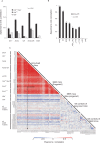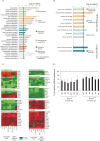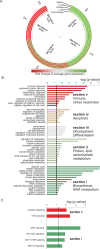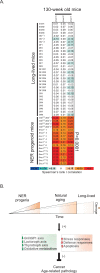Delayed and accelerated aging share common longevity assurance mechanisms
- PMID: 18704162
- PMCID: PMC2493043
- DOI: 10.1371/journal.pgen.1000161
Delayed and accelerated aging share common longevity assurance mechanisms
Abstract
Mutant dwarf and calorie-restricted mice benefit from healthy aging and unusually long lifespan. In contrast, mouse models for DNA repair-deficient progeroid syndromes age and die prematurely. To identify mechanisms that regulate mammalian longevity, we quantified the parallels between the genome-wide liver expression profiles of mice with those two extremes of lifespan. Contrary to expectation, we find significant, genome-wide expression associations between the progeroid and long-lived mice. Subsequent analysis of significantly over-represented biological processes revealed suppression of the endocrine and energy pathways with increased stress responses in both delayed and premature aging. To test the relevance of these processes in natural aging, we compared the transcriptomes of liver, lung, kidney, and spleen over the entire murine adult lifespan and subsequently confirmed these findings on an independent aging cohort. The majority of genes showed similar expression changes in all four organs, indicating a systemic transcriptional response with aging. This systemic response included the same biological processes that are triggered in progeroid and long-lived mice. However, on a genome-wide scale, transcriptomes of naturally aged mice showed a strong association to progeroid but not to long-lived mice. Thus, endocrine and metabolic changes are indicative of "survival" responses to genotoxic stress or starvation, whereas genome-wide associations in gene expression with natural aging are indicative of biological age, which may thus delineate pro- and anti-aging effects of treatments aimed at health-span extension.
Conflict of interest statement
The authors have declared that no competing interests exist.
Figures





Similar articles
-
Adaptive stress response in segmental progeria resembles long-lived dwarfism and calorie restriction in mice.PLoS Genet. 2006 Dec 15;2(12):e192. doi: 10.1371/journal.pgen.0020192. Epub 2006 Oct 2. PLoS Genet. 2006. PMID: 17173483 Free PMC article.
-
Rejuvenating somatotropic signaling: a therapeutical opportunity for premature aging?Aging (Albany NY). 2010 Dec;2(12):1017-22. doi: 10.18632/aging.100262. Aging (Albany NY). 2010. PMID: 21212467 Free PMC article.
-
Mouse models and aging: longevity and progeria.Curr Top Dev Biol. 2014;109:249-85. doi: 10.1016/B978-0-12-397920-9.00003-2. Curr Top Dev Biol. 2014. PMID: 24947239 Review.
-
Gene expression profiling of long-lived dwarf mice: longevity-associated genes and relationships with diet, gender and aging.BMC Genomics. 2007 Oct 3;8:353. doi: 10.1186/1471-2164-8-353. BMC Genomics. 2007. PMID: 17915019 Free PMC article.
-
Calorie restriction and dwarf mice in gerontological research.Gerontology. 2010;56(4):404-9. doi: 10.1159/000235720. Epub 2009 Aug 19. Gerontology. 2010. PMID: 19690401 Review.
Cited by
-
Restricted diet delays accelerated ageing and genomic stress in DNA-repair-deficient mice.Nature. 2016 Sep 15;537(7620):427-431. doi: 10.1038/nature19329. Epub 2016 Aug 24. Nature. 2016. PMID: 27556946 Free PMC article.
-
Genomic Approach to Understand the Association of DNA Repair with Longevity and Healthy Aging Using Genomic Databases of Oldest-Old Population.Oxid Med Cell Longev. 2018 May 3;2018:2984730. doi: 10.1155/2018/2984730. eCollection 2018. Oxid Med Cell Longev. 2018. PMID: 29854078 Free PMC article. Review.
-
Peptide Hormone Regulation of DNA Damage Responses.Endocr Rev. 2020 Jul 1;41(4):bnaa009. doi: 10.1210/endrev/bnaa009. Endocr Rev. 2020. PMID: 32270196 Free PMC article. Review.
-
The DNA damage response: the omics era and its impact.DNA Repair (Amst). 2014 Jul;19:214-20. doi: 10.1016/j.dnarep.2014.03.008. Epub 2014 Apr 30. DNA Repair (Amst). 2014. PMID: 24794401 Free PMC article. Review.
-
When Anti-Aging Studies Meet Cancer Chemoprevention: Can Anti-Aging Agent Kill Two Birds with One Blow?Curr Pharmacol Rep. 2015 Dec 1;1(6):420-433. doi: 10.1007/s40495-015-0039-5. Epub 2015 Apr 14. Curr Pharmacol Rep. 2015. PMID: 26756023 Free PMC article.
References
-
- Hasty P, Campisi J, Hoeijmakers J, van Steeg H, Vijg J. Aging and genome maintenance: lessons from the mouse? Science. 2003;299:1355–1359. - PubMed
-
- Hoeijmakers JH. Genome maintenance mechanisms for preventing cancer. Nature. 2001;411:366–374. - PubMed
-
- de Boer J, Andressoo JO, de Wit J, Huijmans J, Beems RB, et al. Premature aging in mice deficient in DNA repair and transcription. Science. 2002;296:1276–1279. - PubMed
-
- Martin GM. Genetic modulation of senescent phenotypes in Homo sapiens. Cell. 2005;120:523–532. - PubMed
-
- Martin GM, Oshima J. Lessons from human progeroid syndromes. Nature. 2000;408:263–266. - PubMed
Publication types
MeSH terms
Grants and funding
LinkOut - more resources
Full Text Sources
Other Literature Sources
Molecular Biology Databases

